ASBESTOS VERMICULITE
ASBESTOS VERMICULITE Asbestos refers to naturally occurring fibrous mineral silicates. Asbestos hard rock is mined then pulverized and crushed to produce the material asbestos. Asbestos fibers are categorized as either serpentines (curly fibers) or amphiboles (straight fibers). Chrysotile asbestos is classified as Serpentine type. Amosite, Anthophyllite, Crocidolite, Tremolite, and Actinolite are classified as Amphiboles type. All types of asbestos fibers are associated with lung scarring and other asbestos related diseases.
Asbestos Photo Gallery Below
Watch my video (over 20,000 views).
This is an eye opener.
Below are microscopic views of the different types of asbestos.
 Amosite |
 Crocidolite |
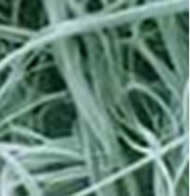 Chrysotile |
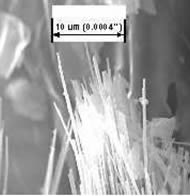 Tremolite—500X finer than its Chrysotile cousin |
Several types of asbestos minerals exist in the Earth’s crust. The most common is chrysotile asbestos. Chrysotile was mined for commercial use in the U.S. and Canada for much of the 20th century. Less common asbestos is tremolite, which was never mined for its own use but contaminated the vermiculite ore that was mined in Libby. This mine produced roughly 80 percent of the world’s vermiculite. Like silica and other minerals, asbestos fibers wedge into the lungs, causing scarring. Scarring builds over time until breathing becomes interrupted. This disease is known as asbestosis. It is incurable and terminal.
Tremolite is 500 times finer than Chrysotile. Tremolite is so small that it can pass through the tissue of the lung, lodging in the outer lining called the pleura. The pleura becomes thick from Tremolite and loses elasticity. This causes mesothelioma cancer. Mesothelioma spreads into the lymph nodes and causes autoimmune disorders. Victims die from suffocation due to fluid build-up around the lungs. It is recorded that over 7,500 people have been diagnosed with asbestos-type illness around the Libby, Montana area.
Many building products can contain asbestos fibers.
Below are some examples where asbestos can be found.
 Asbestos Floor Tiles |
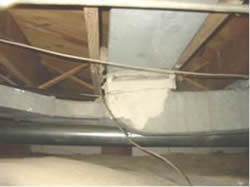 Asbestos Duct Furnace Tape |
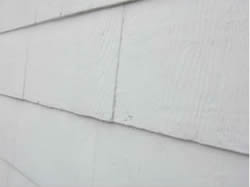 Asbestos Siding |
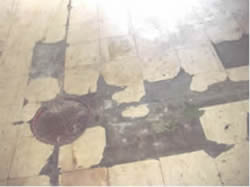 Asbestos Flooring |
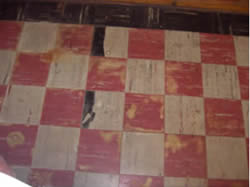 Red Asbestos Floor |
 Black Asbestos Floor |
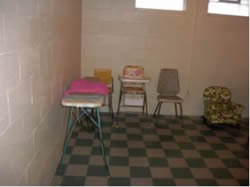 Green Asbestos Floor |
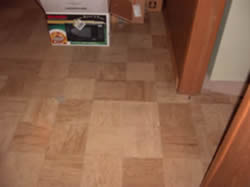 Brown Asbestos Floor |
 Asbestos Floor Tile in a Box |
 Asbestos Insulation in a Roll |
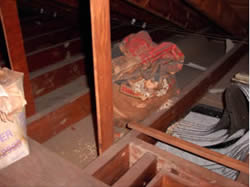 Asbestos in a Bag |
 Asbestos Paper |
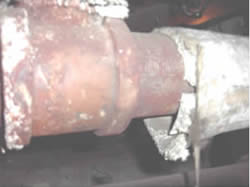 Asbestos on Boiler and Hot Water Heat Pipes |
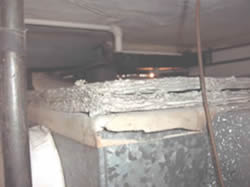 Asbestos HVAC Insulation |
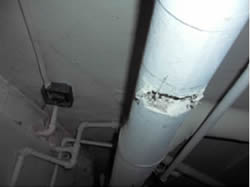 Asbestos on Steam Pipes |
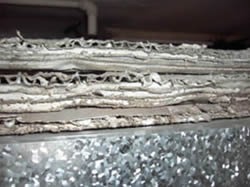 Asbestos Fireproofing |
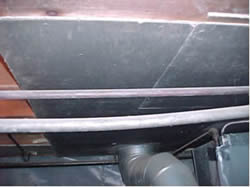 Furnace Asbestos Fireproofing Panels |
 Whole House Asbestos Siding |
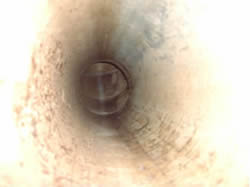 Asbestos Under Slab Ducts— Common in 1950’s and 1960’s |
 Asbestos Insulation Blanket |
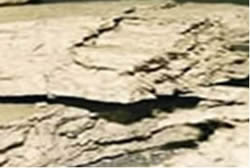 Asbestos Insulation on the Floor |
 Asbestos Drop Ceilings (Remember the Schools) |
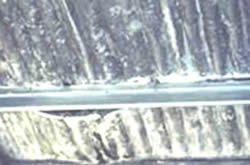 Asbestos Spray On Fireproofing (Similar to World Trade Centers) |
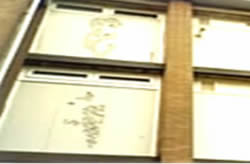 Asbestos Exterior Building Panels (Not So Common) |
 Asbestos Attic Insulation (See Lower Section on Vermiculite) |
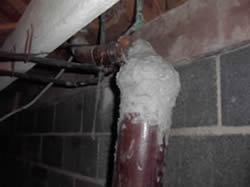 Asbestos Plumbing Repairs |
 Asbestos Insulation on Old Knob and Tube Wiring (Hot Overfused Panel) |
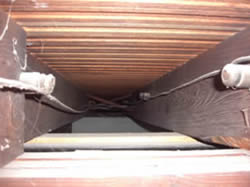 Insulation on Old Knob and Tube Wiring |
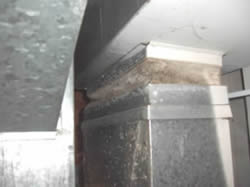 Asbestos on Duct Flexible Connections |
OTHER ASBESTOS SOURCES:
|
VERMICULITE
Newest Best Kept Secret
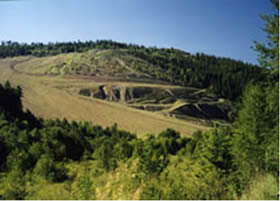 VERMICULITE HIST0RY
VERMICULITE HIST0RY
Vermiculite insulation was manufactured in Dearborn, Elsie, River Rouge, Milan, Warren, Reed City, and Grand Rapids until the 1990’s. Today this material is reportedly found in the attics of about 35 million homes. Much of this Vermiculite originated at the W.R. Grace & Co. mine in Libby, Montana (photo). This mine was contaminated with tremolite asbestos. The tremolite asbestos was mixed in with the Vermiculite oar and shipped all over the country At one time, it provided 80 percent of the world’s vermiculite.)
In some Libby families, up to four living generations are threatened, and several others are already dead. Today, in many Libby homes, the grandchildren have no grandparents and in many cases their parents have been diagnosed with an asbestos type disease. These diseases are incurable and terminal.
This asbestos Vermiculite trail leads from Libby to hundreds of processing and manufacturing plants across North America. This Vermiculie from the W.R. Grace & Co. mine was used to make insulation and gardening materials. In some studies a higher than average incidence of asbestosis actually follows the path of the train tracks from Libby to the processing facilities.
Is Your Attic Insulation Vermiculite?
 Vermiculite Attic Insulation |
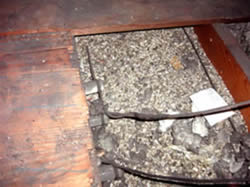 I Would Not Go Up in This Attic |
You can make this identification yourself. Vermiculite is easy to spot; it’s a gold/brown loose material, with nuggets clearly showing a layered texture. It is shiny and glitters. Vermiculite should not be confused withy other common forms of attic insulation used in Ohio as listed below.
Fiberglass Batting. Generally pink or yellow (Pink Panther Guy). Easy to recognize. Should not contain asbestos. Fibers can be irritants. Always use proper respiratory protection when touching or disturbing it. Stay away from attic if this material is exposed.
Cellulose. Generally made out of recycled newspapers. Treated with a fire and mold retardant. Should not contain asbestos fibers. Always use proper respiratory protection when touching or disturbing it.
Mineral Wool (Rock Wool). Fibrous material made from volcanic rock (or from slag from steel, copper, or lead processing), with a binder added to allow it to stick to surfaces after spraying. Irritant if stirred up. Sometimes contains asbestos. Always use proper respiratory protection when touching or disturbing it. Stay away from attic if this material is exposed.
THE BIG VERMICULITE PROBLEMS
Federal regulations define an “Asbestos Containing Material” (ACM) as one that contains at least 1% by weight of asbestos, which in turn is defined as any of these six minerals: chrysotile, Amosite, crocidolite, actinolite, anthophyllite, or tremolite. (The last of which can be found in vermiculite.)
There are several problems with this federal regulation ACM definition:
- The one percent cutoff is not a dividing line between “safe” and “unsafe.” Two pounds of material with 0.5% asbestos content is just as dangerous as one pound at 1.0%.
- Other minerals with similar and also just as dangerous as asbestos fibrous structure are not on the EPA’s list. These materials are richterite and winchite. Both of these minerals are frequently found in vermiculite!
- It’s also possible that asbestos fibers are not detected by the laboratory on any one granule, yet be found on others. For this reason, the EPA recommends that multiple samples be analyzed.
THE GOOD BAD AND THE UGLY
GOOD
- The vermiculite insulation is up in the attic and not in your living space.
- Houses act like giant chimneys. Air flows upward into the attic. In some cases, attic fibers may have a hard time finding their way into the lower conditioned rooms.
- The attic may be 100% sealed from the home with no breaches. This is highly unlikely due to electrical, plumbing, and other mechanical ceiling penetrations.
- The Vermiculite was tested and found not to contain tremolite asbestos. Your test site may not be representative of the entire attic. (Make sure you have accurate testing results before making decisions.)
BAD
- Many homes have forced air HVAC systems with duct work in the attic. These ducts can vibrate from the airflow within them, disturbing the vermiculite and creating airborne fibers.
- Supply ducts, which feed air from the HVAC, are under positive pressure— pushing the air through them to the conditioned living space. These are generally not a problem, due to Vermiculite fibers not being drawn into them. However, if duct leaks exist in the attic, the agitating leaking air will aerosolize attic insulation. This may permit indoor contamination.
- Return ducts are under negative pressure. If the attic return ducts are not 100% sealed (and most are not), vermiculite fibers can get sucked into the system. The return duct system communicates with the indoor conditioned space permitting contamination.
- Pressure difference driving air from house to attic can be affected by wind conditions. This can disturb the vermiculite and create airborne fibers.
- Attic fans, house fans, and other fans can reverse the normal airflow, causing fibers in the attic air to be pulled down into the rest of the house, thus permitting contamination.
- Vermiculite may not be obvious to home owners and building inspectors. Many times, vermiculite is covered and hidden by other types of insulation.
UGLY
|
Removal of attic Vermiculite can cost $10,000-$20,000. Cleaning the entire home with proper HEPA wash down techniques can cost $2,500 and more. Washing all clothes, garments, window covering, cloth furniture, etc. could cost $5,000 and more. |
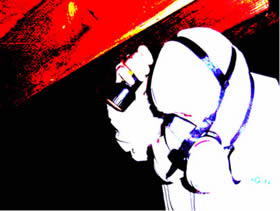 |
TESTING
- Do it yourself. Collect, prepare and submit several samples to a certified laboratory. The cost will probably range from $75-100 each. Be aware that you will be exposed to airborne particulate when sampling. Wearing a proper mask is advised.
- Hire an expert. (Fees are for local clients only)
- A state-licensed asbestos inspector comes to your house, collects a bulk sample, prepares it for analysis, and coordinates with the lab. Cost is $200-$300.
- A state-licensed asbestos inspector comes to your house, collects an air sample (TEM takes 2 ½ hours), prepares it for analysis, and coordinates with the lab. The inspector will turn on the HVAC fan and other fans in the home to help disturb house dust. Cost is $400-$500.
- A state-licensed asbestos inspector comes to your house, collects an air sample (TEM takes 2½ hours), prepares it for analysis, and coordinates with the lab. This inspector creates the worst case scenario using a blower door infiltrometer. This apparatus will be attached generally to the front entrance door. This unit will be turned on for 2½ hours creating a negative house pressure. If the attic has breaches, fibers may enter the home. The blower door will help in this determination. Once the blower door is operating, the inspector will perform the 2½ hour air test. Please call Marko Vovk in the field at 216-924-8378 for questions pertaining to Asbestos or Vermiculite.
- Marko does not do asbestos testing. Marko will give you a referral only.
You can email Marko at Clevelandmold@aol.com.
You can see Marko on YouTube a the ClevelandMarko or Marko Vovk channel
You can subscrive to Marko on Facebook.
Call Marko at 216-924-8327